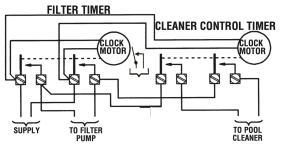- Nov 12, 2017
- 12,640
- Pool Size
- 12300
- Surface
- Plaster
- Chlorine
- Salt Water Generator
- SWG Type
- Pentair Intellichlor IC-40
That's settled!A partial bypass could definitely be done, it would just serve no purpose.
We're shooting in the dark here a bit, as you've yet to provide us a signature that lists your equipment.I know what you're saying, but I have no separate SWCG timer. SWCG comes on with power to the pump and runs in 2 hour cycles or so until the pump turns off. I just want it to turn off after an hour and stay off until power to it goes off and comes back on. Simple. Just don't see such a thing out there.
But let's say you have a one-speed pump controlled by a separate timer. You need a second timer for the SWG, one that allows you to wire the timer circuit and the line/load circuit separately. You'd wire the timer circuit to a breaker that supplies 24-7 power. That's so the timer can keep time. And then you'd wire the SWG to the load side, but the power source for the load (the line side) would not be wired to the same breaker powering the 2nd timer, it would be wired to the load side of the timer running the pump.
Then you bracket the runtimes. Say the pump runs four hours a day. The SWG's timer would be set to run the SWG within the four hours the pump runs.
If the timers get out of whack (they invariably do), or if the pump timer fails for some reason, it won't matter that the SWG timer is "on" when the pump timer is "off," because the power going to the SWG won't be present (because it's coming from the pump timer, not directly from the breaker).
It's hard to describe with text. But that's how it's done. It's a typical wiring setup when there is a booster pump for a pressure-side vac. You bracket the vac schedule within the pump schedule, but even if the timers lose time, the booster pump can't run unless both timers are on.
Intermatic makes a dual timer that is exactly what you need.
On the off chance the pump timer is on, and the SWG timer is on, but the pump has failed and there is no flow, the resulting dangerous scenario, of an SWG running with no flow, is avoided by the flow switch. That's why you need both safeguards (the wiring and the flow switch).
Last edited:




